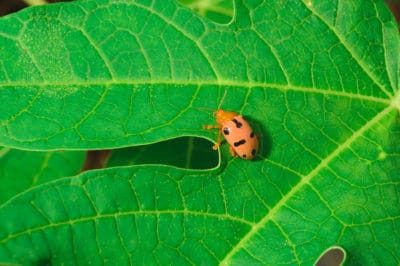Bean Leaf Beetles
The bean leaf beetle can be found in three different forms – red, yellow or tan, and non-spotted. All of these have a triangular black mark on the wing covers just behind the “neck.” Many of these beetles also have two to four black spots present on each wing cover. They may also have a black band around the wing edges. The larvae are white with brown at each end.
Feeding Habits
Bean leaf beetles emerge in the spring when soil begins to warm. The adult beetles will eat the emerging beans and can consume the entire sprout. The following generations of beetles chew small round holes in the plant’s leaves and may also eat pod tissue. They prefer young, tender tissues and may avoid more mature leaves and pods. Larva feed on the nitrogenous nodules of the bean roots.
Damage
Although the larvae don’t generally do too much damage, adult bean beetles can skeletonize an entire plant. As they multiply and more beetles reach adulthood, the planting can be decimated. Damage is worse in warmer areas as the beetles emerge earlier and find plants on which to feed and lay eggs. In those areas, two generations are common and a third may occur if conditions are right.
Strategies for Control:
Organic gardeners have several options to control bean leaf beetles. These include:
- Row covers for emerging bean plants.
- Hand picking; drop beetles into soapy water.
- Delay planting; beetles will starve without food.
- Use companion plants to repel the insects.
- Release parasitic wasps – bean beetles’ natural enemies.
- Plant trap crops of soybeans, then remove and burn infested plants.
Garden Clean-Up
Since bean leaf beetles overwinter in plant debris, garden sanitation is one of your primary weapons in the fight to keep them under control. Remove all plant debris from the garden and burn it if you have experienced an infestation. Don’t put bean leaves or vines in compost piles. Pick up boards under which the beetles might hide in the cold seasons.
Garden Patrol
Bean leaf beetles are small – only about ¼ inch in length. You may be more likely to see feeding damage than the beetles themselves. Unless you have a major infestation, you might not even realize they’re in your garden. Check your plants between noon and 4 P.M., which is when they are most likely to be active.
